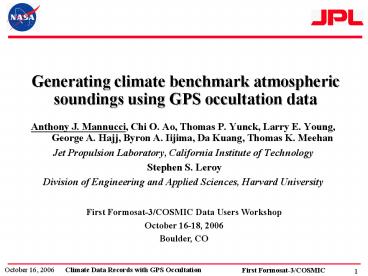Generating climate benchmark atmospheric soundings using GPS occultation data - PowerPoint PPT Presentation
1 / 21
Title:
Generating climate benchmark atmospheric soundings using GPS occultation data
Description:
'Sweet spot' for climate. October 16, 2006. First Formosat-3/COSMIC. 6 ... 16. Climate Data Records with GPS Occultation. COSMIC Profile Comparisons. COSMIC3 - COSMIC2 ... – PowerPoint PPT presentation
Number of Views:32
Avg rating:3.0/5.0
Title: Generating climate benchmark atmospheric soundings using GPS occultation data
1
Generating climate benchmark atmospheric
soundings using GPS occultation data
- Anthony J. Mannucci, Chi O. Ao, Thomas P. Yunck,
Larry E. Young, George A. Hajj, Byron A. Iijima,
Da Kuang, Thomas K. Meehan - Jet Propulsion Laboratory, California Institute
of Technology - Stephen S. Leroy
- Division of Engineering and Applied Sciences,
Harvard University
First Formosat-3/COSMIC Data Users Workshop
October 16-18, 2006 Boulder, CO
2
Overview of Todays Talk
- How GPS RO can become a climate benchmark
- Identify and analyze error sources
- Look at what we know from a different perspective
- Error analysis for realistic L2 tracking
- Future directions
3
Establishing a climate benchmark
2 a a point of reference from which
measurements may be made b something that
serves as a standard by which others may be
measured or judged
- Systematic errors assessed by comparison to
independent observations - Accuracy standard based on SI-traceability
- Error analysis
- There will not be an independent measurement of
exactly the same quantity - Documented absolute accuracy
- Methods for establishing accuracy must be
documented and widely accepted - Adequate archiving and transparency
- Appropriate management infrastructure
- Geophysical meaning for climate
- Measurement coverage and density
4
Approach Overview of Error Analysis
Ohring et al., BAMS 2005 Satellite Instrument
Calibration for Measuring Global Climate Change
- Extensive analysis conducted by Kursinski et al.,
JGR 1997 - Linear error propagation
- Simulation
Minor impact
Limit range of validity
Error categories
Further work needed to establish SI-traceability
Additional discussion in Generating climate
benchmark atmospheric soundings using
GPS occultation data, Proceedings of the SPIE
Conference, San Diego CA, 2006, Mannucci et al.
5
Errors Limiting Measurement Interpretation For
Temperature
Upper altitude limit low SNR, upper altitude
initialization (temperature), ionosphere
Sweet spot for climate
Lower altitude limit water vapor
6
Systematic Errors That Might Impact Trend
Measurements
- Focus on troposphere trend requirement 0.04
K/decade - Systematic errors that vary over time
- Ionosphere
- 11-year solar cycle
- Orbit determination error
- Requirement 0.05 mm/sec or better
- Possible trends in OD strategy or results
- Need to establish SI-traceability of orbit errors
- Local multipath
- Varying satellite generations
7
Solar Cycle Variation
8
Modeled Electron Density Variations
9
Residual Ionosphere Error After Dual-Frequency
Correction
Method ray-trace signal through a model
ionosphere
From the solar maximum simulation of Kursinski et
al. JGR, 1997
10
An Instrumental Source of Ionospheric Error
- Extrapolation of L2 iono bending below 15 km
SAC-C July 1, 2006
Median 11.6 km
Number of Occultations
2
22 km Cutoff Height
12
11
Simulation Results Extrapolation Error
Temperature errors 0.1 K
12
GRACE Error Analysis August 2006
- Differences between measured and extrapolated L2
Solar Min
13
Role Of Ionospheric Error
- Simulations suggest gt 0.1 K systematic error over
the solar cycle - Processing methods can be modified to reduce this
error - Use data-driven global ionospheric models to
compute bending explicitly - Flag cases with large ionospheric irregularities
- Use new GPS signals (to maintain L2 lock)
14
Studying Ionospheric Irregularities
Quiet (80 of cases)
Disturbed
- From Pavelyev et al., GPS Solutions 2005
15
Comparing COSMIC Profiles
16
COSMIC Profile Comparisons
Inter-quartile Range Contains central 50 of
differences
COSMIC3 - COSMIC2
Median
Window 30 km 10 minutes June 4-16, 06 224 pairs
1 K
17
COSMIC Refractivity Comparison
Median
Inter-quartile Range
COSMIC3 - COSMIC2
Window 30 km 10 minutes June 4-16, 06 224 pairs
1
18
COSMIC3 - COSMIC1
Inter-quartile Range
COSMIC3 - COSMIC1
Median
Window 30 km 10 minutes June 4-16, 06 80 pairs
1 K
19
Interpretation
- Errors addressed with COSMIC comparisons
- Instrumental bias
- Non-common orbit error
- Multipath (most of it)
- Errors not addressed with COSMIC comparisons
- Ionosphere
- Temperature initialization
20
Questions For The Community
- Are we taking the steps necessary to enure that
on-orbit SI-traceability can be verified a few
decades from now? - 0.04 K/decade requirement
- Are all necessary data being stored?
- Are instrument software being archived?
- What steps are needed to establish in-orbit
absolute calibration (SI-traceability)? - Ionosphere
- Orbits
- Multipath
- Cycle slips, quality control
- What is optimal processing strategy for climate
records?
21
Summary and Conclusions
- Work remains to establish on-orbit
SI-traceability for GPS radio occultation
retrievals - Existing analyses suggest the need for reducing
residual ionospheric error - Goal climate-oriented retrieval products with
full traceability to absolute standards - Recent results with COSMIC instruments are very
encouraging































